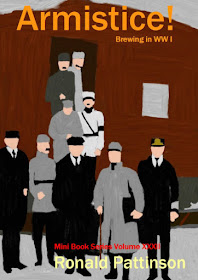That’s just a warning to not take as gospel that the following beers are IPAs. They might have been. Or maybe not. The distinction was probably lost on most drinkers, anyway.
PI 60/- was Drybrough’s strongest Pale Ale/IPA at the start of the war. Though it’s weaker than a top-class London Pale Ale would have been.
In the first couple of years of the war, it didn’t change a great deal, losing just four gravity points. It was dropped in 1917, probably in April. This was the time when gravity restrictions kicked in. Unlike some breweries, which slashed gravities but kept the name of the strongest beer, Drybrough discontinued the strongest.
| Drybrough PI 60/- 1914 - 1920 | |||||||
| Date | Year | OG | FG | ABV | App. Atten-uation | lbs hops/ qtr | hops lb/brl |
| 31st Dec | 1914 | 1054 | 1018 | 4.76 | 66.67% | 5.07 | 1.12 |
| 12th Jan | 1915 | 1053 | 1018 | 4.63 | 66.04% | 6.01 | 1.29 |
| 7th Jan | 1916 | 1053 | 1017 | 4.76 | 67.92% | 5.02 | 1.10 |
| 28th Jul | 1916 | 1050 | 1015 | 4.63 | 70.00% | 3.95 | 0.85 |
| 16th Jan | 1917 | 1048 | 1016 | 4.23 | 66.67% | 3.95 | 0.80 |
| 13th Feb | 1917 | 1044 | 1017 | 3.57 | 61.36% | 4.04 | 0.74 |
| 10th Jul | 1919 | 1036 | 1009 | 3.57 | 75.00% | 4.93 | 0.73 |
| 15th Oct | 1919 | 1039 | 1012 | 3.57 | 69.23% | 4.34 | 0.83 |
| 29th Jul | 1920 | 1039 | 1012 | 3.57 | 69.23% | 5.20 | 0.86 |
| Sources: | |||||||
| Drybrough brewing record held at the Scottish Brewing Archive, document number D/6/1/1/3. | |||||||
It reappears in the records in the middle of 1919, with its gravity even further reduced. Its gravity then stabilised just under 1040º for the rest of the 1920’s. However, in 1920 they introduced a new beer, PI 80/- with an OG of 1054º - exactly the same as PI 60/- had been before the war. Confusing, isn’t it?
| Drybrough PI 60/- 1914 - 1920 | |||||||||||
| invert sugar | |||||||||||
| Date | Year | OG | pale malt | flaked maize | no. 1 | no. 2 | no. 3 | caramel | malt extract | dxt | BSC |
| 31st Dec | 1914 | 1054 | 81.91% | 8.19% | 4.10% | 5.46% | 0.34% | ||||
| 12th Jan | 1915 | 1053 | 82.66% | 8.55% | 3.80% | 4.75% | 0.24% | ||||
| 7th Jan | 1916 | 1053 | 81.47% | 8.81% | 3.67% | 5.87% | 0.18% | ||||
| 28th Jul | 1916 | 1050 | 85.87% | 4.40% | 3.67% | 5.87% | 0.18% | ||||
| 16th Jan | 1917 | 1048 | 80.61% | 9.21% | 3.84% | 6.14% | 0.19% | ||||
| 13th Feb | 1917 | 1044 | 80.50% | 10.06% | 3.35% | 5.87% | 0.21% | ||||
| 10th Jul | 1919 | 1036 | 91.18% | 0.00% | 8.82% | ||||||
| 15th Oct | 1919 | 1039 | 78.83% | 4.38% | 6.57% | 10.22% | |||||
| 29th Jul | 1920 | 1039 | 70.45% | 19.43% | 1.62% | 1.21% | 7.29% | ||||
| Sources: | |||||||||||
| Drybrough brewing record held at the Scottish Brewing Archive, document number D/6/1/1/3. | |||||||||||
Like the gravity, there’s not much change in the early war years. It’s not the most fascinating of recipes, just pale malt, flaked maize and some sugar. With all the changes being in the type of sugar used. Though we don’t see that in action as PI 60/- had already been discontinued by the time the restrictions on sugar use began in 1917.
This is another exccerpt from my book on the Great War, Armistice!.
Buy this wonderful book.


No comments:
Post a Comment